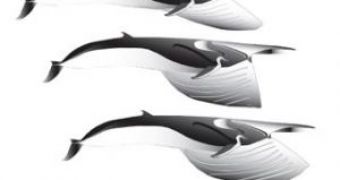Whales may be the largest animals ever, but, despite this, the pharynx of the baleen whales (true whales) is so narrow that they cannot swallow anything larger than a herring. Still, their enormous mouths suggest they have a huge gulp. And in some species, the so-called rorquals, that include humpback whales and blue whales (world's largest species), the ventral skin folds can lead this to an extreme in the animal world.
These species can take during the feeding lunges gulps with a water volume of a school bus, as found by a team at the University of British Columbia and the University of California, Berkeley, and published in the journal Marine Ecology Progress Series.
For a few seconds the whale doubles its size, before squeezing the water out through the baleens to filter for small fish or shrimp-like krill.
"The scale of this activity almost defies imagination," said co-author Nicholas D. Pyenson, a UC Berkeley graduate student in the Department of Integrative Biology and the Museum of Paleontology.
The team investigated the fin whale (Balaenoptera physalus), the world's second largest whale after the blue whale. It can reach 88 ft (29.3 m) in length and feed in a series of lunges, 6 to 10 seconds each, taking huge gulps of krill-rich water. The lunges can be 35 ft (12 m) deep.
"All of this happens underwater," Pyenson said, which makes studying the mechanics of these feeding lunges difficult." said Pyenson.
But, in the last years, videos delivered by critter cams attached to whales through suction cups offered enough data on speed, body positioning and swimming strokes. This could be combined with biomechanics research made on whale skeletons and baleens from museum collections.
The team could measure this way a gulp's volume: 60 to 82 cubic meters (2,100 to 2,900 cubic feet) in the case of a 20 m (66 ft) long adult fin whale. The energy spent for making these underwater open-mouthed lunges through the water limits whale's ability to dive deeper.
"Large whales should theoretically be able to stay underwater longer than smaller whales, yet fins and blues typically dive for only seven minutes, much shorter than the predicted time. The lunge creates an incredible amount of drag and essentially stops the whale dead in the water. So any subsequent movement requires an acceleration from rest, which comes at a high energetic cost." said Jeremy A. Goldbogen, graduate student of the University of British Columbia in Vancouver.
"Because fin whales often lunge seven times per dive, such feeding behavior could rapidly deplete a whale's oxygen and require it to resurface before more feeding. Each mouthful, however, can bring around 25 pounds (11 kg) of krill, which means a whale could meet its daily energy requirements in about four hours of hunting." he added.
"The ecological and evolutionary benefits of lunge feeding seem to outweigh the energetic costs of the lunge. The advent of lunge feeding seems to have favored the evolution of the world's largest living creatures. But it's an idea that needs further testing." said Pyenson.

 14 DAY TRIAL //
14 DAY TRIAL //